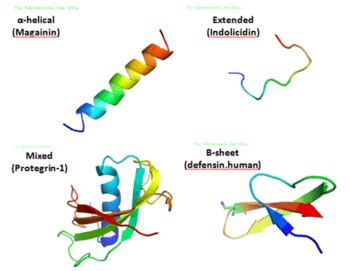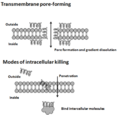Host defence peptide facts for kids
A Host defence peptide (or antimicrobial peptide) is one of a part of the innate immune response. They are found among all classes of life.
They act against invading microorganisms. The peptides kill Gram negative and Gram positive bacteria. This includes strains which are resistant to conventional antibiotics. The peptides also work against mycobacteria (including Mycobacterium tuberculosis), enveloped viruses, fungi and even transformed or cancerous cells.
These peptides are excellent candidates for medical use. They complement conventional antibiotic therapy. They have a broad range of activity, and are bactericidal as opposed to bacteriostatic. They need only a short contact time to kill bacteria.
There are big differences between prokaryotic and eukaryotic cells as targets for antimicrobial peptides. These peptides are potent, broad spectrum antibiotics. Unlike most antibiotics it seems that antimicrobial peptides may also improve immunity by working as immunomodulators (beefing up the immune system).
Related pages
Images for kids
-
Scanning electron microscopic images (50,000X magnification) displaying the action of an experimental antimicrobial peptide (NN2_0050) on the cell membrane of E. coli (K12 MG1655) [1] ABOVE: Intact cell membranes in the control group. BELOW: Disrupted cell membranes and leakage of bacterial chromosome (green) in the treated group.
See also
 In Spanish: Péptido antimicrobiano para niños
In Spanish: Péptido antimicrobiano para niños





